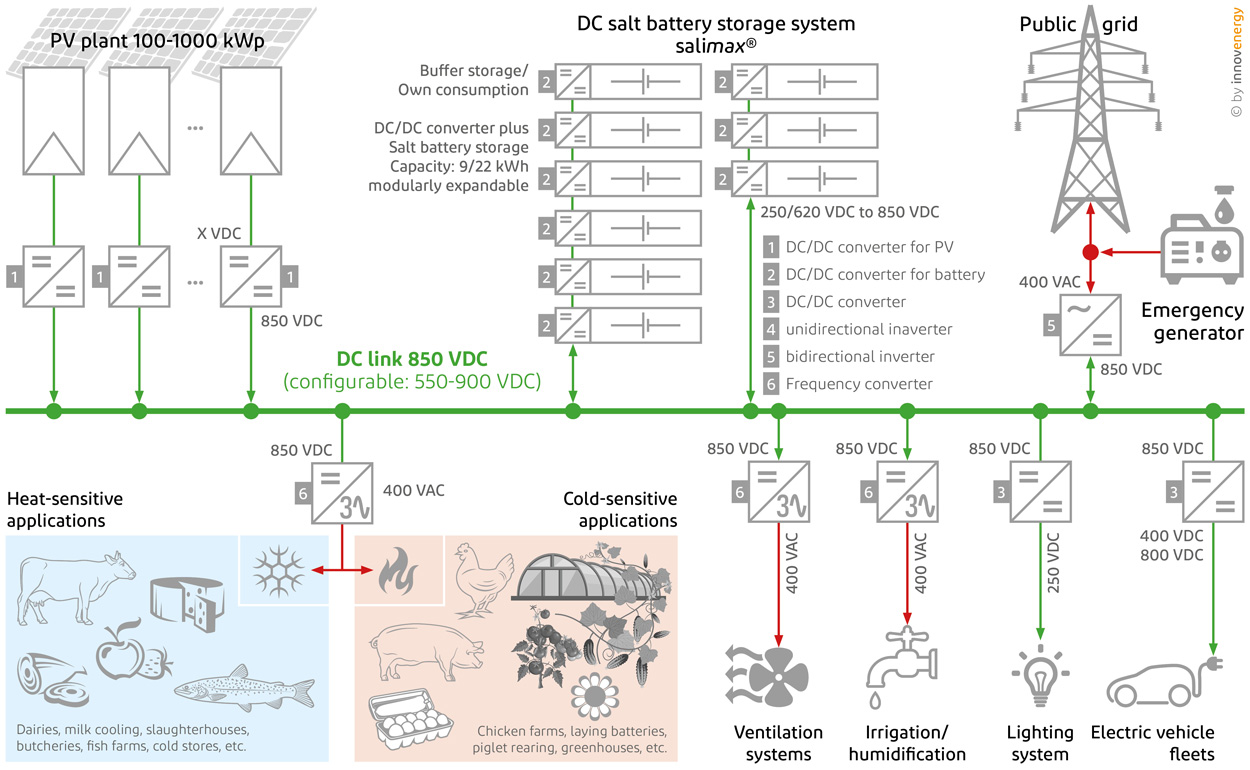More than double land use with Agri Photovoltaics
Agri-photovoltaics is not new and has been a topic of interest to farmers and engineers for ten years. But agri-photovoltaics alone does not mean electricity self-sufficiency. Feeding it into the grid entails enormous dependence on the grid operator – on the one hand due to constantly changing feed-in tariffs and on the other hand due to limitations on the grid connection capacity. Only the combination with battery storage to optimise self-consumption and the expansion of one's own direct current grid for highly efficient self-consumption or direct sale to neighbours creates true self-sufficiency and independence.
Huge potential
If we take a brief look at the facts, it becomes clear how we could most easily achieve the energy turnaround. Worldwide, 14 gigawatt peak are currently generated from agri-photovoltaics. The technical potential in Germany alone is around 1700 gigawatt peak. However, exploiting this huge area potential will lead to problems in the public grid, which is not able to manage such non-continuous energy. The advantage for the farmer is to double the land use at a lower cost than rooftop photovoltaic systems.
Possibilities of Agri-Photovoltaics
Agri-Photovoltaics means to use the available agricultural land several times at the same time. On the one hand, through conventional agricultural crop production and, on the other hand, through various types of photovoltaic overbuilding. In this way, solar electricity is generated on the same land area via the previous agricultural use, which is usually fed into the public grid and generates additional income.

Grassland management with agri-photovoltaics
© EWS Consulting GmbH/ews-sonnenfeld.com

Trellised fruit under transparent solar modules
© Fraunhofer ISE/www.ise.fraunhofer.de

Solar farming with movable bridge modules
© GOLDBECK SOLAR GmbH/www.goldbecksolar.com
Whether a meadow is partially covered with photovoltaics and sheep, goats, cows or chickens graze underneath, or the meadow is mown several times a year, is just as feasible as normal field farming with solar cells that provide sufficient height and distance for threshers. Trellised fruit or berry cultivation under solar panels produce particularly good yields. Greenhouses fully covered with solar make sense for shade crops or those that need artificial light anyway. There are agri-photovoltaic systems for crab or fish farms that produce the necessary electricity right on the roof due to their heat intensity.
There are very different photovoltaic concepts for Agri-PV. Depending on the application, there are translucent or swivelling solar modules, through permanently installed opaque modules to movable module bridges. The possibilities are manifold, but the increased expansion of agri-photovoltaics requires additional grid expansion in order to be able to guarantee higher connected loads to match the installed photovoltaic system. This expansion is expensive and time-consuming. Neither the grid operator nor the farmer wants to pay for it. For this reason, agri-photovoltaics is often only used on a reduced scale, on smaller areas that match the connected load, or not at all.

Critical grid connection capacities often make it impossible to utilise the full photovoltaic potential

Within an own DC grid, the self-produced electricity can be fully utilised and reduces the grid connection power
Plant protection
Also worth mentioning is the protection of the plants under the solar panels from heavy rain, hail, frost and heat, which will become increasingly important in an environment of increased natural disasters due to climate change. It has been found that the plants under the panels use less water. Likewise, the temperature at the height of the plants is a few degrees lower, which cools the solar panels and makes them work more efficiently. In summer, when it is sunniest, the energy consumption for water pumps or cooling is also highest for certain types of cultivation, and the necessary electricity is immediately available. For field workers, it is also much more pleasant to work in the shade or protected from the weather.
Optimising self-consumption with battery storage
Energy efficiency is even more beneficial when the self-produced electricity can be used much more for one's own operations – not only when the sun is shining, but also in the evening and night hours. Heat or water pumps, dwellings, stables, hay tedders, milking machines, cooling, ventilation, heating or other machines and consumers can all be supplied by the farm's own electricity. But the milking system, for example, runs when the solar system is not yet or no longer supplying full energy, or the laying battery, which should also be heated overnight. All this electricity must then be drawn from the grid again at high cost. This can be avoided if during the day the energy surpluses flow into a battery storage system, preferably a sustainable salt battery, instead of into the grid. In this way, one's own electricity is also available overnight.
Eco-power in eco-storage
These salt-based battery storage systems are fully recyclable, consist exclusively of environmentally friendly materials and are extremely durable. They are expected to last at least 15 years and are maintenance-free. It is a technology that has been tried and tested for over twenty years. These battery storage systems are available for immediate delivery via short transport routes. Only products from European value chains are used in the battery systems. The raw materials are also sourced from Europe. The salt batteries are extremely robust and run even at temperatures from -20° to +60° Celsius. They can be installed almost anywhere - only it should be dry. The battery efficiency is 90 percent. They have a high energy density and are absolutely safe: they do not burn, they do not explode, nothing can leak. Therefore, no structural measures are necessary before they can be installed.
«Eco-power stored in eco-batteries», is the motto of the Swiss company innovenergy®.
You can find out more about these salt battery storage systems on the manufacturer's website: www.innov.energy

salidomo® – Salt battery storage system from 9 to 36 kWh capacity with 9 or 15 kVA power

salipro® – Salt battery storage system with 45 or 90 kWh capacity and 45 kVA power

salimax® – Salt battery storage system from 45 to 2000 kWh capacity
High-efficiency DC grid and emergency power
Some farmers have the problem that they are too far away from the nearest electricity supplier and often only receive «dirty electricity», electricity with many fluctuations or voltage peaks. This often leads to breakdowns and repairs of machinery. An own stand-alone grid based on direct current ensures constant electricity without fluctuations with simultaneous self-sufficiency when the public grid fails. In particular, heat- or cold-sensitive farms with battery cages, breeding stables or cooling systems etc. urgently need a fail-safe system, because lives are at risk if there is a power failure.
Likewise, conversion losses from direct current from the solar cell to alternating current into the domestic grid and then back to direct current into the battery and from there back into the domestic grid with alternating current are considerable. Up to 40 percent of the energy is lost in the process, energy that you could put to better use. A sensible way would be to install a so-called DC link, a cable connection with freely selectable direct current voltage. Producers and consumers are directly connected to this DC link. The following graphic clearly shows how this can look on a farm.

Emergency power
In the event of a grid failure, the system automatically switches over in less than 20 milliseconds and continues to function autonomously. The photovoltaic power is no longer available. However, the battery system can continue to be used until it is completely discharged.
Off-grid operation
With an off-grid battery storage system, the photovoltaic power is still fully or partially available in the event of a grid failure. The battery can continue to be charged. Surpluses can also be consumed in the off-grid system. This extends the duration of self-sufficiency. Here, too, the system switches automatically in less than 20 milliseconds.

DConnect® is an application concept for an own DC grid. The central point is the DC link with its freely selectable DC voltage. Via AMPTs, the solar energy is sent into the DC-Link and flows into the storage battery, which also needs direct current. Due to the extremely low conversion losses, the energy efficiency is almost 99 percent. All DC consumers with DC/DC converters, such as lighting or e-charging stations, are also connected to the DC link. Various machines can be operated directly via frequency converters or the power is fed into the house's AC grid via an inverter. An emergency power or PTO generator can also be integrated. Producers and consumers in the DC grid balance themselves out in a self-regulating manner. Energy surpluses can still be fed into the public grid, but this will be less since all your consumers were previously served with your electricity. And, the surpluses can be designed in such a way that the feed-in corresponds to the connected loads.
Mehr Informationen unter:
www.dc-connect.systems





